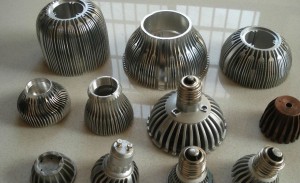The commonly used cooling material for electric devices is aluminum. In some special cases, copper is also used, like CPU. Copper better than aluminum in capacity of heat-transmission but worse in capability of heat radiation. Compare two radiators with same construction but made by different materials, radiator made by aluminum are better in natural cooling. However, if cooling fans are taken into account, the result is opposite. Recently, a lot of LED manufacturers tend to introduce ceramic, conductive plastics and graphite material into their LED cooling technique. What are the particular performances of these new cooling materials for LED lamps?
Ceramic: the firstly used cooling material is a type of ceramic with porous structure. The original purpose of this radiator is to raise the coefficient of heat transfer by increasing the surface area. In fact, this method is infeasible. The real thermal conductivity of this radiator is only 15 W/(m oC), even lower than alumina (a commonly use ceramic material for cooling technique). Thermal effect of it is much worse than the aluminum plate. Thus this oldest ceramic cooling material exited for a very short time and disappeared thoroughly.
Conductive plastics: this is a new LED Street Light cooling material turned up in recent years. If you study specifications of this material, you will find it has a very low thermal conductivity (only 15 W/(m oC)). Some plastics have better capabilities of surface heat radiation than aluminum. However, tests results indicated that this cooling material is only suitable for low powered LED lamps. They have very similar working effects with aluminum alloy when used in low powered LED lamps (lower than 2W). For high powered LED lamps, the cooling efficiency is even worse than the material mentioned before. The final temperature of LED PN junctions for a 6W LED Spot Lights (using this type material as radiator) is up to 92 oC. Although some plastics have good capability of heat radiation, but thermal conductivity of them is too low. They absorb those heat generated by LED chips in a very slow rate. If the heat generated by LED chips dramatically exceeds their digestion, they will lose the cooling function completely. Similar to porous structured ceramic, conductive plastics did not exist very long in LED lighting market.
These two cooling materials for LED lamps are not competent. In next section, we are going to discuss the performance of graphite material.

